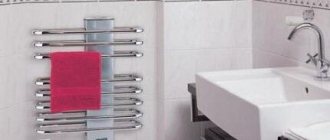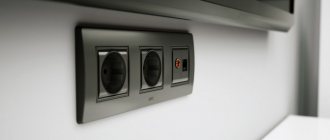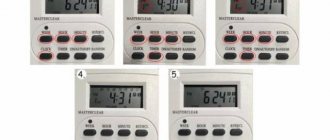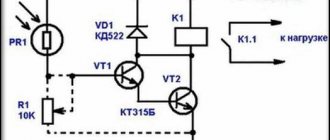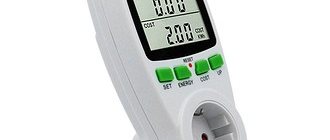Time relays are designed to implement a given sequence of turning on and off various devices, circuit elements, and signaling. Using temporary control devices, specified switching and control delays are formed. Most designs of time control devices provide for adjustment of the duration of the on or off interval. Depending on the design of the time relay, adjustment can be carried out mechanically, electronically or by software.
What to look for when choosing
Before you start choosing an outlet with a timer, you need to decide whether it is needed at all, and if it is needed, then in what capacity and for what purposes. This is due to the fact that the degree of process automation and, accordingly, the type of timer depend on the purpose. When choosing an outlet with a timer, the main criteria are indicators such as:
- Electrical power - this indicator determines how much power the load can be connected to a specific device model, and, accordingly, how much current can flow through the timer for a long time.
- Degree of protection – determines the possibility of placement in a particular place (indoors or outdoors, in damp or dusty rooms).
- Cyclic operation and settings parameters determine the possibilities of use in automatic mode and the functionality of the device.
- The manufacturer's brand determines the reliability of the device.
List of used literature
- Figurnov E. P. “Relay protection” 2004
- Iglovsky I. G., Vladimirov G. V. “Handbook on low-current electrical relays” 1984
- Filipcheiko I, P., Rybin G. Ya. “Electromagnetic relays” 1968
- Gurevich V.I. "Electrical relays. Device, principle of operation and application. Engineer's Handbook" 2011
- Andreev V.A. “Relay protection of power supply systems in examples and tasks” 2008
- Bass E.I., Doroguntsev V.G. “Relay protection of electric power systems” 2002
Types of sockets with on and off timers that you can buy
All devices on the market that have a forward or backward time countdown function can be divided into types according to control features and functionality. According to the first parameter, all devices are divided into mechanical and electronic on/off timers according to a given program. Mechanical models are the simplest type of device for turning electricity on/off
Mechanical sockets with timer
Mechanical ones are the simplest and most affordable. In the photo of a socket with a timer you can see the dial and sectors around the entire perimeter. It is adjusted by scrolling the timer to the desired time sector and pressing the button. Typically the time interval is from 15 to 30 minutes.
Pros. Easy to use and low price.
Minuses. They only come with daily settings; you need to set them up yourself every day. The parameters are clearly limited; they can be turned on only with a certain repetition, every 10 minutes, 20, etc.
Electronic socket timer
The second, more complex type is an electrical timer, which has the right to be called a full-fledged programmer. Some models have up to 140 different operating modes. Additionally, an electronic socket timer can have a built-in motion sensor, the operation of which is adjusted for a certain period of time. This is very convenient if you connect a timer to the lighting system to get a source of emergency light.
Electrical outlets have approximately the same set of buttons, making them easy to configure
Electronic sockets are additionally divided into two types in accordance with the maximum time period that can be set to turn on or off:
- Daily allowance . An option that involves maintaining the operation of the device throughout the day or 24 hours, and the set parameters will be repeated day after day. This is not the most convenient mode, since a person's daily routine may change, which will require reprogramming.
- Weekly . The main advantage of this type is the ability to set a certain rhythm of work for each day of the week separately or group them.
For your information! Electronic timers for a 220 V socket operate completely silently, so they do not create inconvenience and are almost invisible.
The DIN rail timer can be either electric or analog.
GSM socket
It is part of the “smart home” system, and therefore it is also called a “smart socket”. In appearance it looks like a simple overlay without any buttons or screen.
There are several control methods: via SIM card, with an application or remote control. In the first case, you will have to insert a SIM card into the gadget and create templates for SMS messages that it will send to you. In the second option, everything is controlled from a smartphone through an application; to connect, it is enough to have access to the network.
It turns out that you can regulate the operation of a programmable device from any distance and from anywhere in the world, all you need is Internet access or a mobile network signal. But this also lies the main drawback: if problems with the connection begin, then it becomes impossible to regulate the actions.
The number of options in such multifunctional devices is amazing, but you will have to pay a lot for all these pleasures.
Timers for DIN rail mounting
This type is mounted directly into the electrical panel.
Such devices help automate processes on an industrial scale, for example, in enterprises or factories. But if necessary, it can easily be used in everyday life, for example, to organize the switching on of street lighting or to automate the warming up of a car at the right time. Externally, the device is similar to an automatic machine, which has grooves for mounting on a DIN rail. Only it has a display and control buttons. Typically this timer is designed for use in high current networks.
Types of mechanisms
The purpose of using these mechanisms is to close and open the conductor through which electric current flows. The general function is to perform some action after a certain time period. Thanks to modern modifications of devices, you can save a lot on electricity, which is why they are often used in lighting systems not only for public buildings, but also for entrances, private houses and courtyards. Device types:
- monoblock;
- modular.
Monoblock ones are built into electrical appliances. They are self-contained devices that have their own power supply inside, as well as the necessary connection inputs. This type does not have its own body. It is installed in the main device and is its element. The modular device complements electrical appliances.
According to the method of operation, the following types of time relays are found:
- mechanical with clock mechanism;
- mechanical with anchor mechanism;
- electronic;
- motor.
There are also products with pneumatic or electromagnetic retardation. The most widely used are electronic time relays. They allow you to set a timer for several days. At the same time, they have quite compact sizes and low power consumption.
Where can it be used?
Electrical Appliance Control
This includes almost any electrical equipment: home appliances, heating, water pumps for irrigation, aquarium equipment, heating and lighting of animal enclosures. Schedule on-off intervals, automate the process, and in some cases even realize significant energy savings.
Turning lights on and off
By setting an outlet with a timer for a certain time interval, you don’t have to worry about turning on the light in the yard at night and then turning it off in the morning. A socket with an electronic timer will do everything for you. It is also not replaceable in case of long-term absence of the owners. Lighting in the house will scare away burglars by creating the appearance of people being present.
Agricultural management
A socket with a mechanical timer is relevant for owners of a summer cottage, vegetable garden, and greenhouses. Automatic watering after a set period of time will free up a lot of your time. You can also set up the supply of water or light for animals if you have a farm.
What to look for when choosing an electronic timer
When purchasing, you should decide not only on the type of device, but also pay attention to the main technical characteristics and parameters that affect the operation of the device:
- Programming time frames. Everything is simple here. If you need to control the voltage only throughout the day, a simple mechanical model is selected. If weekly or even monthly management is required, an electronic option with the availability of appropriate options is selected.
- Accuracy. This characteristic is more relevant for mechanical models. Although for most tasks that are assigned to timers, accuracy down to seconds is not important. For optimal performance, it is necessary to choose products from trusted manufacturers.
- Load. Depending on the network load, you must select the appropriate device. There are models that can withstand a load of 7 A, 10 A and 16 A. The choice of indicator will depend on the power consumed by the device powered through this outlet.
- Number of programming lines. This parameter shows how many devices can be shorted to the timer. The simplest samples support only one device, more advanced models have 2 or more lines.
- Dust and moisture protection. Some devices may have additional protection against the negative effects of environmental factors. This is typical for timers intended for outdoor use.
There are samples that have reliable protection from external factors for outdoor use
Adjusting digital equipment
The use of devices with mechanical settings can be explained using the example of the REV Ritter timer. It plugs into the most common household outlet. With the help of this device, control of any home appliance is monitored within the required time frame. It is configured as follows:
- All elements around the disk are raised.
- Only elements that are opposite the required time value are omitted.
- The dial is turned to set the current time.
For example, if you omit segments with numbers 15 and 21 on the disk, then after the device starts operating, the power will be connected at 15 o’clock, and the circuit will break at 21 o’clock. The design of the REV Ritter mechanism involves the organization of 48 periods in a full day.
The equipment also has the ability to externally connect the load. To enable this function, there is a separate button located on the side of the case. If you click on it, power will be supplied to the device without taking into account the settings.
How to set a timer to turn electrical appliances on and off
Regardless of the brand and design of the timer and the location of its installation, the settings of devices of the same type are performed in the same way, namely:
- Setting up mechanical devices. Sockets with a mechanical timer are equipped with a rotating drum, on which there are markings that determine the cycle of switching on and the time interval. For models intended for installation on a DIN rail, the setting is performed using rotary controls, through which each parameter is set separately.
- Tincture of electronic devices. To set the operating modes of this type of timers, use the buttons located on the device body: TIMER and WEEK, DAY and ON, OFF and AUTO, as well as CLOCK, MINUTE and HOUR. The process of setting up a specific model is reflected in the operating instructions included in the package.
Electronic models are configured using buttons located on their body
How to set up an electronic socket timer
There are many varieties and models of electronic socket timers. But in general, the principle of setting them up is similar. Almost all of them are equipped with a liquid crystal display that displays settings and current menu items. Below it there is a row of buttons for controlling and setting the time.
Usually the set of buttons on different timers is the same
Their set is usually the same on different models. Here is a list of commonly encountered controls:
- master clear . The instructions for timers usually begin initializing the device. It is a button for resetting all settings from memory, including resetting the current time. By the way, the button may simply be called reset or “reset”;
- random or rnd . Setting or resetting the random start mode;
- clk or clock. The button is responsible for several functions. Setting the time with the hour, min, week buttons. Together with the timer button, it converts time formats;
- timer. Actually, setting a timer. Used in conjunction with the week, hour, min buttons;
- rst/rcl. Disabling and enabling programs;
- week/hour/minute . Setting the time for a week, an hour a minute.
In general, installing and configuring an electronic on/off timer according to a given program is no more difficult than on a simple electronic wristwatch. Buttons may have different names depending on the manufacturer or may even be localized into Russian.
Features of setting the electronic TE-15 IEK timer in accordance with the instructions for use
One of the most popular models on the market is the TE-15 digital timer, which is produced by several manufacturers. Its configuration scheme is as follows:
- After turning on, the first thing you need to do is press the reset button and wait until the built-in memory is completely cleared.
- Next, you need to set the current time and day of the week. The first indicator can look like “24” and “12”. The days of the week are named after the first letters of Latin words. The desired parameter is set using the “D+”, “H+” and “M+” buttons.
- The timer has 4 operating modes, which can be selected by pressing a similar key.
- To start programming, you need to press the “P” button and sequentially set the days of the week and the start time. The end of the program cycle will be pressing the “P” key again.
- The next step is to set the days of the week and the shutdown time; confirmation of the action is completed by pressing the “H+” button.
Advantages and disadvantages of such devices
The use of such devices simplifies the operation of various electrical equipment and household appliances, so the advantages of an outlet with a timer include the following indicators:
- is it possible to automate the process of turning on and off loads for various purposes? This is especially true for electronic devices;
- with correct settings, you can achieve a reduction in electrical energy consumption;
- The consumer sets the operating mode of the connected load elements independently in accordance with his schedule and rhythm of life;
When calculating for the consumed electrical energy in a two-tariff mode of use, the reduction in costs for paying bills, in the case of using sockets with a timer, can be reduced by 20-30%.
- in models with a built-in battery, the settings are saved even when the centralized power supply is turned off, which allows the connected devices to continue operating in the same cycle after voltage is supplied to the electrical network;
- the ability to create a simulation of the presence of people in an empty apartment (country house) will make it possible to secure it from illegal entry by unauthorized persons;
- The operating mode can be configured for a long service life.
Socket with a mechanical timer.
Models equipped with an electronic timer have the main disadvantage that when the centralized power supply is turned off, the timer operation process does not stop, but works “by itself.” This may be undesirable when connecting heating appliances to such devices or turning on household appliances during a given use cycle (night time, etc.).
Model "TG-14A"
Devices with a mechanical control type have several more disadvantages, these include:
- inaccuracy of work in relation to the hourly cycle;
- the device “ticks” during operation, which can interfere, especially at night;
- programming mode is limited and lasts up to 24 hours;
- wear and tear of the timer mechanism leads to limited service life for such devices.
Principle of operation
The time relay is equipped with a contact group. It is with its help that switching on and off occurs. The controller is a coil, which is an electromagnet, or a clock mechanism. In analog and electronic devices, a quartz oscillator is used. With its help, impulses are formed that determine the passage of time. The devices operate according to the following principle:
- A signal is sent to the device.
- The required number of pulses is pre-programmed in the device.
- Once the required indicator is reached, some action occurs.
- The time counter goes back to zero, after which the whole process is repeated.
An electronic (digital) time relay replaced the analog mechanical one. Such devices are controlled using anchors, which change contacts with a certain delay. The device operates by changing the voltage across the capacitor. The design has a special unit. It operates on RC circuit. It is this element that sets time. At the required period, a command is sent to the relay. The device either closes or opens contact pairs that are included in the circuit.
Modern devices are complemented by a microcontroller, with which a person can program the device without disassembling it. This type does not require any specialized setup. It begins to function immediately after connecting to the power supply. These relays can be set to delay from 1 second to several weeks. The design includes:
- magnetic wire;
- a special non-magnetic gasket (it must be present for correct operation);
- anchor.
To slow down the switching, a short-circuited winding is often used. When electric current is applied to it, a magnetic field appears, which creates an obstacle to the increase in magnetic force. This significantly reduces the armature response time. Pneumatic devices operate thanks to a damper. The delay is controlled by an air hole, the cross-section of which can be changed.
You might be interested in: Principles and sources of free energy according to the Tesla scheme
TOP 8 popular models of sockets with a timer
Theben Timer 26
The simplest but most reliable model from the German manufacturer Theben.
It is characterized by high reliability and durability. When completing the on-off cycle, it notifies you with a characteristic click. Unlike Chinese analogues, it works completely silently when the timer is set. There is no light indication, but given its other advantages, this is not critical. Maximum load - 16A. The company has proven itself to be the best and produces high-quality equipment of European quality. Naturally, the price for this rather simple model is not the lowest and is about 1800 rubles.
